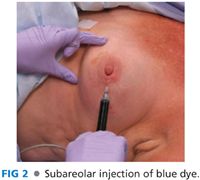■ Intravenous lines, pulse oximeter devices, and blood pressure cuffs should be placed on other extremities if possible.
TECHNIQUES
INJECTION OF RADIOACTIVE TRACER AND/OR BLUE DYE
■ Use of dual tracer has been shown to be associated with higher identification and lower false-negative rates3; however, particularly in patients undergoing skin-sparing mastectomy, surgeons may wish to forego blue dye, as the dye may discolor the skin and make it more difficult to evaluate for skin ischemia or necrosis.
■ In general, the radioactive tracer used is technetium Tc 99m sulfur colloid. For patients not undergoing lymphoscintigraphy, the tracer can be injected in the preoperative holding area. However, injection of this material is painful, and adequate counts can often be obtained with intradermal injection after induction of anesthesia. The radiotracer can be injected peritumoral, intradermal (in the skin over the location of the cancer), or periareolar (four intradermal injections around the areola). If injection is done on the same day as the operative procedure, a dose of 0.5 mCi is adequate. If injection is done the day prior to surgery, 2.5 mCi should be used.
■ Both isosulfan and methylene blue dye have been used for SLN biopsy; they vary in their color, complication profile, and cost. Isosulfan blue is a more azure blue (which is easier to distinguish from venous structures) but is associated with less than 1% risk of anaphylaxis4 and is significantly more costly than methylene blue. Methylene blue is darker, associated with a higher rate of skin necrosis, but is far cheaper.5 In general, 5 mL of these tracers are used; if methylene blue is chosen, it should be diluted 1:2 with saline.
■ Blue dye may be injected peritumoral or using a subareolar approach. The latter allows for lymphatic mapping of multiple tumors and those which are not easily identifiable6 (FIG 2). For patients undergoing breast conservation, the subareolar approach may leave the patient with a “blue breast” for some time.

PREPPING AND DRAPING
■ The arm is prepped circumferentially along with the breast. The arm is draped into the field and kept free such that the surgeon may move the arm in a sterile fashion during the case (FIG 3).

INCISION
■
Stay updated, free articles. Join our Telegram channel

Full access? Get Clinical Tree








